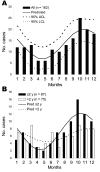Mycobacterium avium lymphadenopathy among children, Sweden
- PMID: 18394289
- PMCID: PMC2570918
- DOI: 10.3201/eid1404.060570
Mycobacterium avium lymphadenopathy among children, Sweden
Abstract
We studied Mycobacterium avium lymphadenopathy in 183 Swedish children (<7 years of age) from 1998 through 2003. Seasonal variation in the frequency of the disease, with a peak in October and a low point in April, suggests cyclic environmental factors. We also found a higher incidence of the disease in children who live close to water.
Figures


References
-
- Wolinsky E. Mycobacterial lymphadenitis in children: a prospective study of 105 nontuberculous cases with long term follow-up. Clin Infect Dis. 1995;20:954–63. - PubMed
-
- Romanus V, Hallander HO, Whålén P, Olinder-Nielsen AM, Magnusson PHW, Juhlin I. Atypical mycobacteria in extrapulmonary disease among children. Incidence in Sweden from 1969 to 1990, related to changing BCG-vaccination coverage. Tuber Lung Dis. 1995;76:300–10. 10.1016/S0962-8479(05)80028-0 - DOI - PubMed
Publication types
MeSH terms
LinkOut - more resources
Full Text Sources
Medical
Miscellaneous
